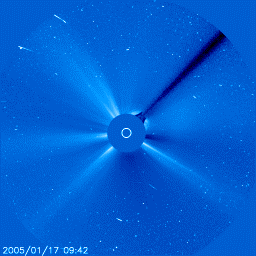Perfect Space Storm Could be Catastrophic on Earth, Study Concludes

The sun works on a pretty well known 11-year cycle of activity, all measured by sunspots and solar flares.
But like the stock market, the sunspot cycle is unpredictable. And just when astronomers thought it had hit bottom, it went lower. It has been a bear market for sunspots for many months now. That also means there have been no major space storms, which can zap satellites and threaten power grids on Earth.
There were no sunspots observed on 266 days during 2008, or 73 percent of the time. The last year things were quieter was 1913, which had 311 spotless days. Some observers figured the solar cycle had hit bottom in 2008.
But the sunspot recession is not over. Sunspot counts for 2009 have dropped even lower, the space agency announced today. As of March 31, there were no sunspots on 78 of the year's 90 days (87 percent).
"This is the quietest sun we've seen in almost a century," said sunspot expert David Hathaway of the Marshall Space Flight Center.
Why it matters
It matters because scientists would like to be able to predict when things will pick up, and when the next "solar maximum" will occur. At peak activity, tentatively expected in three or four years, more and more powerful solar storms up the odds of a satellite failure or a power grid malfunction.
Get the Space.com Newsletter
Breaking space news, the latest updates on rocket launches, skywatching events and more!
Solar storms pack charged particles that slam into our atmosphere and, when they penetrate, can cause a cascade of failures in satellites and power systems.
A recent report by National Academy of Sciences concluded that a major storm during the next peak could cripple power grids and other communications systems and could be catastrophic, with effects leading to a potential loss of governmental control of the situation.
Other records set in 2008:
A 50-year low in solar wind pressure: Measurements by the Ulysses spacecraft reveal a 20 percent drop in solar wind pressure since the mid-1990s -- the lowest point since such measurements began in the 1960s. The solar wind helps keep galactic cosmic rays out of the inner solar system. With the solar wind flagging, more cosmic rays are permitted to enter, resulting in increased health hazards for astronauts. Weaker solar wind also means fewer geomagnetic storms and auroras on Earth.
A 55-year low in solar radio emissions that might -- or might not -- indicate weakness in the sun's global magnetic field.
A 12-year low in solar irradiance: Several NASA spacecraft find the sun's brightness has dropped by 0.02% percent at visible wavelengths and a whopping 6 percent at extreme UV wavelengths since the solar minimum of 1996.
These changes are not enough to reverse the course of global warming, the agency stated, but there are some other, noticeable side-effects: Earth's upper atmosphere is heated less by the sun and it is therefore less "puffed up." Satellites in low Earth orbit experience less atmospheric drag, extending their operational lifetimes. Unfortunately, dangerous space junk also remains longer in Earth orbit, increasing hazards to spacecraft and satellites.
"We're experiencing a very deep solar minimum," said solar physicist Dean Pesnell of the Goddard Space Flight Center.
What's up?
All these lows have sparked a debate about whether the ongoing minimum is "weird", "extreme" or just an overdue "market correction" following a string of unusually intense solar maxima.
"Since the Space Age began in the 1950s, solar activity has been generally high," notes Hathaway. "Five of the ten most intense solar cycles on record have occurred in the last 50 years. We're just not used to this kind of deep calm."
Deep calm was fairly common a hundred years ago. The solar minima of 1901 and 1913, for instance, were even longer than the one we're experiencing now. To match those minima in terms of depth and longevity, the current minimum will have to last at least another year.
Pesnell believes sunspot counts will pick up again soon, "possibly by the end of the year," to be followed by a solar maximum of below-average intensity in 2012 or 2013.
- Video - How Space Storms Wreak Havoc on Earth
- World to End in 2012 (Check Back for Updates)
- Gallery: Solar Storms
Join our Space Forums to keep talking space on the latest missions, night sky and more! And if you have a news tip, correction or comment, let us know at: community@space.com.

Rob has been producing internet content since the mid-1990s. He was a writer, editor and Director of Site Operations at Space.com starting in 1999. He served as Managing Editor of LiveScience since its launch in 2004. He then oversaw news operations for the Space.com's then-parent company TechMediaNetwork's growing suite of technology, science and business news sites. Prior to joining the company, Rob was an editor at The Star-Ledger in New Jersey. He has a journalism degree from Humboldt State University in California, is an author and also writes for Medium.









